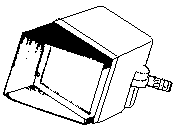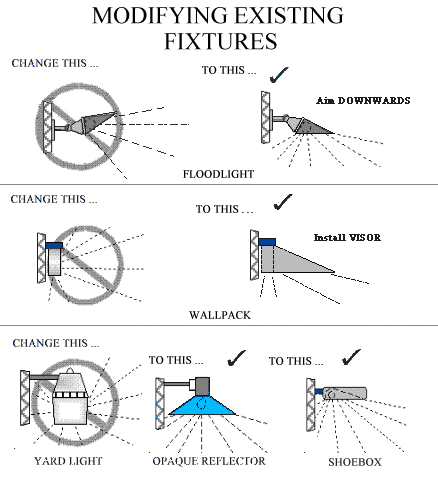Any lamp - no matter how faint - can be annoying in certain circumstances, so it is encouraged that all outdoor lights be fully shielded. However, with fixtures that use dazzling lamps (typically all HPS, mercury vapor, and metal-halide lamps, and clear incandescent lamps of 150 watts or greater), the requirement for shielding is imperative. Here is a list of some good lighting fixtures, with manufacturers or suppliers names, product numbers, and addresses (with telephone numbers in parentheses).
Please note that this is not a comprehensive list of all good lighting fixtures; these are a sample of those fixtures that have come to the attention of NELPAG as of the winter of 1995. As other quality fixtures are brought to our attention, they will
be included in future updates. Please do give us your suggestions.
ABOLITE: 10000 Alliance Road; Cincinnati, OH 45242 (513-793-8875)
GENERAL ELECTRIC: Hendersonville, NC 28739 (800-626-2000)
GUTH LIGHTING: 2615 Washington Blvd.; St. Louis, MO 63103 (314-533-3200)
HADCO: P.O. Box 128; Littlestown, PA 17340 (717-359-7131)
HUBBELL LIGHTING: 2000 Electric Way; Christiansburg, VA 24073 (703-382-6111)
KIM LIGHTING: P.O. Box 1275; City of Industry, CA 91749 (818-968-5666)
LUMINAIRE TECHNOLOGIES, INC.: 212 West Main St.; Gibsonville, NC 27249 (910-449-6310)
THOMAS & BETTS LIGHTING DIV.: 1555 Lynnfield Rd.; Memphis, TN 38119 (901-682-7766)
THOMAS OUTDOOR LIGHTING (formerly McPhilben Outdoor Lighting): 2661 Alvarado St.; San Leandro, CA
PEMCO LIGHTING PRODUCTS: 150 Pemco Way; Wilmington, DE 19804 (302-892-9003)
RUUD LIGHTING: 9201 Washington Ave.; Racine, WI 53406 (414-886-1900)
SPERO LIGHTING: 1705 Noble Rd.; Cleveland, OH 44112 (216-851-3300)
STONCO: P.O. Box 129; Union, NJ 07605 (908-964-7000)
VOIGHT LIGHTING: 135 Fort Lee Rd.; Leonia, NJ 07605 (201-461-2493)
WESTERFIELD: 770 Gateway Center Dr.; San Diego, CA 92102 (619-263-6672)
In the diagrams, the following abbreviations are used: INC = incandescent; HPS = high-pressure sodium; CF = compact fluorescent; MH = metal-halide; MV = mercury vapor
| AREA LIGHTS - POLE or BUILDING MOUNTED |
THOMAS & BETTS
American Electric Lighting
Package "C" (Cutoff)
(HPS, MV)
Low Cost

|
KIM LIGHTING
Series SAR
(HPS, MH, MV)
High Cost

|
PEMCO
Model 8908X-211-CO
(HPS, MH, CF, INC)
Medium Cost

|
RUDD LIGHTING
PR Series
(HPS, MH, CF, INC)
Medium Cost

|
STONCO
Series RLM3000 & RMS3000
(HPS, MH)
Medium Cost

|
HUBBELL LIGHTING
Model NPU-BI
NITE-TO-LITEtm
(HPS, MV)
Low Cost

|
| AREA LIGHTS - BUILDING MOUNTED ONLY |
GUTH LIGHTING
SUNDOWNER Series B1870
(CF, HPS, MV)
Medium Cost

|
KIM LIGHTING
Series WD14D
(HPS, MH)
High Cost

|
McPHILBEN OUTDOOR
Series 101 & 102
(HPS, MH)
High Cost

|
RUDD LIGHTING
E8 Series
(HPS, MH)
Low Cost

|
VOIGT LIGHTING
PRAGMATIC Series 221 & 222
(HPS, MH, MV, CF, INC)
Low to Medium Cost

|
COST:
LOW COST: under $100
MEDIUM COST: $100 - $200
HIGH COST: over $200
|
| SIGN LIGHTS - FLOODLIGHTS |
ABOLITE
Series RLM model DWB-1
(INC)
Low Cost

|
HADCO
Series HF4000 with MGS-3H shield
(HPS, MV)
Medium Cost

|
HUBBELL LIGHTING
Series 308 bullet with 309-S shield
(INC)
Low Cost

|
SPERO LIGHTING
Model 705 reflector1
(INC)
Low Cost

|
STONCO
Series 940 with 9455E shield
(INC)
Low Cost

|
WESTERFIELD
Series 500 with Glare shield
(CF)
Low Cost

|
| ROADWAY LIGHTING |
CROUSE HINDS
Model RAL Series
(HPS, MV)
Medium Cost
|
GENERAL ELECTRIC
Model M-250R2 with CUTOFF OPTICS
(HPS, MV)
Medium Cost

|
HUBBELL LIGHTING
Model RMC series
(HPS, MH)
Medium Cost

|
PEMCO LIGHTING
Model Admiral Hat
(HPS, MH, CF, INC)
Medium Cost

|
THOMAS & BETTS
American Electric Lighting
Roadway Cutoff Series 113 & 125
(HPS, MH, MV)
Medium Cost

|
|
RETROFIT SHIELDS FOR "DUSK TO DAWN"
SECURITY LIGHT |
LUMINAIRE TECHNOLOGIES
Lite-Blockertm
Fits on all NEMA Head Luminaires
Low Cost

|
HUBBELL LIGHTING
Model NPU-BI
NITE-TO-LITEtm SKYCAP
Cutoff Optics
Fits on all NEMA Head Luminaires

|
* * *
This pamphlet was produced by the New England Light Pollution Advisory Group (NELPAG), a volunteer organization established in 1993 to address outdoor-lighting issues locally in the northeastern United States. The chief architect of this pamphlet is Peter Talmage, an engineer residing in Kennebunkport, Maine. Numerous revisions have occurred in the past year, with the main editing by Talmage, Daniel Green, David Crawford, Steve O'Meara, and Joy Hoskins.
The NELPAG produces a Circular at irregular intervals, available either via postal mail - by sending self-addressed, stamped envelopes to Daniel Green (M.S. 18, Smithsonian Observatory, 60 Garden St. Cambridge, MA 02138) - or via computer e-mail (send your full name, postal address, and e-mail address to : NELPAG-REQUEST@harvee.billerica.ma.us via Internet). The NELPAG also meets occasionally in various locations in New England to discuss local lighting issues.
The NELPAG (http://cfa-www.harvard.edu/cfa/ps/nelpag.html) supports the International Dark-Sky Association (http://www.darksky.org) and recommends that all individuals/groups who are interested in the problems of light pollution and obtrusive lighting should subscribe to the IDA Newsletter (IDA membership costs $30.00 per year; send check to International Dark-Sky Association, 3545 N. Stewart, Tucson, AZ 85716). IDA also issues useful "Information Sheets" and slide sets for use in educational presentations.



























